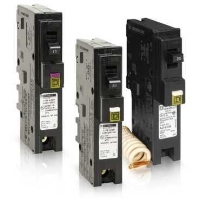NEW 2015 Canadian Electrical Code Requirements for Arc-Fault Protection
What is an Arc Fault?
CAFI - Schneider Homeline
An arc-fault is an unintended arc created by current flowing through an unplanned path. Arcing creates excessive heat that can easily ignite surrounding materials, such as wood framing or insulation, resulting in a hazardous fire.
Typical causes of arc faults are:
-Arcing in installed electrical wiring from physical damage such as:
- Wires accidentally punctured by nails or screws
- Cables that are stapled tightly against wall studs
- Animal and vermin chewing through wiring insulation
- Heat, humidity and voltage stress
- Arcing at loose connections or joints in the circuit or at outlets
- Arcing in appliance or extension cords
- Bent or crimped cords
- Brittle or aged cords
- Cords under or behind furniture
Arc-Fault Circuit Interrupters
Today’s arc-fault technology, available in both circuit breaker and receptacle form, has been proven via the use of arc-fault circuit breakers, saving lives and property as an industry standard for more than 15 years. The technology has gone through several iterations to reduce unwanted tripping due to non-hazardous arcs that are part of the normal operation of appliances and devices in the home.
Both AFCI circuit breakers and receptacles are designed to detect both series and parallel arcing conditions. However, an AFCI receptacle will not protect against parallel arcing upstream of the device as the current path does not flow through the AFCI receptacle. A combination AFCI circuit breaker will protect the entire circuit.
Understand the 2015 Canadian Electrical Code Provisions
In simplified terms, arc-fault circuit protection is required in 15A and 20A-125V circuits supplying receptacles throughout the home with the exception of those outlined in the 2015 Canadian Electrical Code.
Be reminded that enforcement and interpretation of the code is up to the discretion of the provincial and local inspection authority having jurisdiction.
The new Rule 26-724(f) of the 2015 Canadian Electrical Code requires all branch circuits in dwelling units supplying 125V receptacles rated 15A or 20A to be protected by a combination-type arc-fault circuit interrupter (AFCI), except that branch circuits supplying receptacles installed in accordance with Rules 26-710 (f) and 26-712(d) (i), (iii), (iv) and (v), and those supplying only one receptacle for the connection of a cord-connected refrigerator or sump pump, are exempt from the requirement for arc-fault protection.
Mario A. LeBlanc, co-founder






